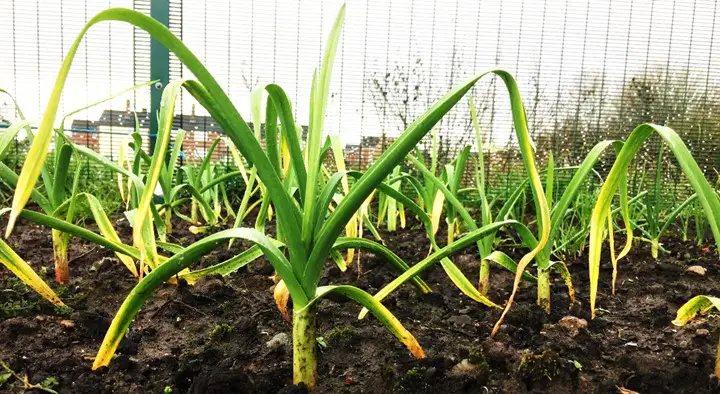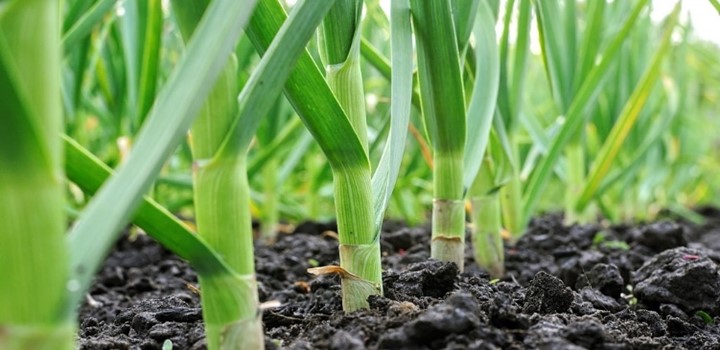Many people believe that leaf yellowing isn’t a huge problem, but it is for Garlic. Why? Because the leaves are symbolic of the Garlic that grows underground. As a result, if you find that your Garlic leaves are turning yellow, you should be aware of the causes and possible treatments.
Now, you might be wondering why my garlic leaves are turning yellow. In a nutshell, unbalanced watering, fertilization, and fungal infections are the major causes.
The good news is that this article covers both the causes and remedies for garlic leaf yellowing. I trust that after reading the article, you will be able to fix this problem on your own. So, without further ado, let’s get going-
What Causes Garlic Leaves Turn Yellow

1. Over & Underwatering
Watering is a severe issue for both small & large-scale growers. It is because the water level of soil highly depends on environmental temperature & soil condition. Let’s see how Garlic responds to imbalanced watering-
Causes
Being a root crop, Garlic needs a sufficient amount of water to grow its bulbs. Why? Because without enough water, it won’t be able to uptake necessary nutrients for growth & chlorophyll synthesis. And due to lack of chlorophyll, leaves turn yellow eventually.
Now you may ask, how overwatering Garlic is a problem? Well, in that case, water molecules replace soil oxygen & create a soggy environment. As a consequence, the roots start rotting & fail to supply water, oxygen & nutrients for growth & chlorophyll production.
Symptoms
Along with yellowing, leaves begin to wilt, and the plant eventually dies. Using a moisture meter (Our pick: Atree Soil Soil Tester Kits with Moisture, Light, and PH Test for Garden). to obtain an idea of the soil water is one approach to assess if the soil is overwatered or underwatered. Another option is to look at the leaves.
If the leaves are dry, it’s because they’ve been underwatered. However, if the yellow and drooping leaves are slightly squishy, it is most likely due to overwatering.
Control Measure
You can tackle the problem of underwatering by establishing a watering plan, but overwatering is a real concern.
Repotting or transplanting the Garlic plant in a different soil is the easiest technique to remedy this. Another option is to let the soil totally dry before properly watering it. However, it is not a certain strategy to get back on your feet.
Preventive Measure
To avoid this, the greatest solution is to meet Garlic’s needs to the fullest extent possible. 1 inch of water per week is required for garlic.
But this isn’t always the case. In cool seasons, they require far less water than in hot ones.
2. Nutrient Deficiency
Water-soluble nutrients are the food of any plant in this world. The same goes for Garlic.
Causes
Garlic needs all of the essential nutrients for optimal growth, although nitrogen, phosphorus, potassium, iron & magnesium are the most desired.
Lack of these nutrients reduces the efficiency of critical physiological functions like respiration, chlorophyll production, photosynthesis, etc. And it finally causes the leaves to turn yellow.
Symptoms
Some of the common symptoms of nutrient deficiency are-
- Yellowing of older leaves from base to tip. It mostly occurs in garlic because of nitrogen deficiency.
- The Tips of garlic leaves turn yellow.
- Tips & edges turn yellow but the middle of the leaves remains green.
Control Measure
If you are certain about nutrient deficiency, you can cut off the completely yellow leaves because they are not going to recover. And then you can start maintaining a fertilizer schedule with the best fertilizer for garlic (Our Pick: Jobe’s Organics Bone Meal Fertilizer).
Preventive Measure
Provide fertilizer during the growing season & which is fall & spring. Most gardeners face the yellowing of garlic leaves in the early spring due to improper fertilization.
3. Diseases
In the whole garlic plant growing cycle, disease management is the topmost issue that you should pay attention to. Because if you satisfy all of the prerequisites but are unable to control the disease, the result is zero.
Causes
The causal agent of most Garlic diseases is different fungi species. Some common fungal diseases are-
- Fusarium Basal Rot
- Penicillium decay
- Botrytis neck rot
- White rot etc.
Fungi affect both the leaves and the bulbs. Some of them stay externally in the leaf, but they survive by sucking the leaf cell fluid. Some fungi, on the other hand, penetrate into the leaf cell, settle there, and begin draining nutrients and water from the xylem tissue.
Thus, they either suck the chlorophyll content or block chlorophyll synthesis, causing the leaves to become yellow as a symptom.
Symptoms
Though different fungi develop different types of diseases, some common symptoms are-
- Leaves turn yellow to brown
- Bulbs turn red to purple
- Stunted growth & wilting
- Visible fungal growth on the bulb, etc.
Control Measure
Once a fungus has taken hold, it is impossible to completely eradicate it. However, if you catch signs early enough, you might be able to prevent additional damage. As a result, you must select the best fungicide for your Garlic (Our Pick: Bonide Copper Fungicide) and apply it according to the manufacturer’s instructions.
Preventive Measure
The best preventive measure is to keep your garden & garden instruments clean. Other measures could be watering sufficiently, keeping your garden weed-free, well-drained & applying fungicide as a preventive measure.
Final Words
Leaf yellowing is a unique technique for plants to communicate with you about a problem. Garlic leaves are crucial because the more leaves there are, the larger the cloves. As garlic is a root crop, it relies on good leaves to produce a healthy bulb. That is why you should pay attention to leaf yellowing.
However, you now know what causes Garlic leaves to turn yellow. So don’t hold your breath. Determine whether the cause is a watering issue, uneven fertilization, or fungal infection. Then set the control measure and finish the job. All the best to you.
